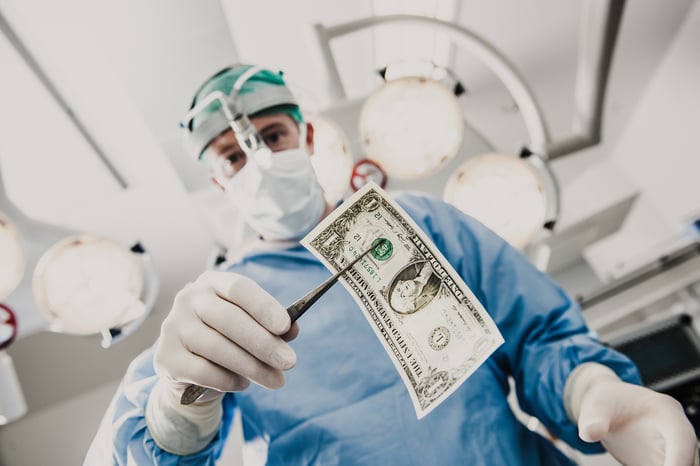As recently as 30 years ago, investors could buy into more than five dozen publicly traded companies that bore the most coveted of all credit ratings, AAA. According to ratings agency Standard & Poor's, the AAA rating signifies that an "obligator's capacity to meet its financial commitments on the obligation is extremely strong."
In determining credit ratings, agencies such as S&P take a number of factors into consideration:
- The likelihood of payment, which includes the willingness of an obligator to meet the financial terms of its commitment.
- The nature and provision of the financial obligation in question.
- The protection afforded by the financial obligation in the event of bankruptcy or reorganization.
In other words, if you bought into a business that had a AAA rating in the early 1990s, you were perceived to be buying into a company that was viewed as rock-solid.

Image source: Getty Images.
Virtually no stocks, or even the U.S. government, bear the AAA credit rating any longer
However, times have changed, at least on the rating front.
In August 2011, the United States, which is the largest country in the world by annual gross domestic product, lost its coveted AAA rating. Standard & Poor's wound up knocking the United States' long-term credit rating down one notch to AA+, with the ballooning federal budget deficit following the Great Recession the ultimate culprit of the downgrade.
Less than five years later, in 2016, integrated oil and gas giant ExxonMobil (XOM -0.72%) would also lose its pristine AAA credit rating for the first time since 1949. With crude oil prices plunging from north of $100 a barrel to under $30 for a brief time in 2016, it caused ExxonMobil's skyrocketing debt levels to stick out like a sore thumb.
And ExxonMobil's not alone. Almost every single company that sported the AAA credit rating in the early 1990s has seen that rating reduced over the past 30 years. This includes conglomerate General Electric, drug giants Pfizer and Merck, beverage behemoth Coca-Cola, and logistics company UPS, to name a few.
Put simply, as lending rates fell steadily over many decades, access to capital became cheaper. This cheap money enticed a number of publicly traded companies to up their leverage, ultimately resulting in a lowering of their credit rating.

Image source: Getty Images.
The only two stocks with a higher credit rating that the U.S. government
But the AAA rating isn't a total unicorn -- at least not yet. There are two blue chip stocks that still possess S&P's highest credit rating, which means they're viewed as less of a risk to meet their financial debt obligations than the United States government!
Johnson & Johnson
The first stock that's as rock-solid financially as they come is healthcare conglomerate Johnson & Johnson (JNJ -1.59%). Despite carrying around $30.2 billion in debt, Johnson & Johnson also sports $17.9 billion in cash, and has generated $21.4 billion in operating cash flow over just the past 12 trailing months. According to Wall Street projections, this operating cash flow should expand to an estimated $28.7 billion by 2021.
What makes J&J such a success is the company's three-pronged business model. In essence, each of its three segments brings something to the table that makes J&J better. For instance, consumer healthcare products is the company's slowest-growth segment, but it provides highly predictable cash flow and healthy pricing power. Medical devices has been a bit of a drag in recent years, but it provides the long-run growth opportunity for an aging global population with improved access to medical care. Finally, pharmaceuticals provide the juiciest margins and generally strong pricing power, but are constrained by the finiteness of patent protection. All three of these segments work together to make Johnson & Johnson the steady company it is today.
Just how rock-solid is J&J? In April 2019, it raised its dividend for the 57th consecutive year. You can probably count on two hands how many publicly traded companies are working on a longer streak. What's more, J&J has reported 36 consecutive years of adjusted operational earnings growth. Unless Johnson & Johnson were hit with a lawsuit of truly mammoth proportions, I can't foresee it losing its AAA rating.

Image source: Getty Images.
Microsoft
The only other stock that can tout a higher credit rating than the U.S. government is Microsoft (MSFT 0.74%). There had been some speculation that Microsoft could lose its AAA rating when it sold nearly $20 billion worth of debt in 2016 to acquire LinkedIn, but this rumor never materialized into fact. Today, Microsoft is carrying around $87.2 billion in debt on its balance sheet, but also has $134.2 billion in cash and generated $54.1 billion in operating cash flow over the trailing 12-month period.
What makes Microsoft so special is that it's winning with both legacy software and next-generation cloud services. A company its size ($1.4 trillion market cap) isn't expected to be growing sales by 14% year-on-year, but that's exactly what it did during the fiscal second quarter. Legacy products continue to perform well, with Office 365 Commercial seeing 30% constant currency sales growth from the prior-year period. Meanwhile, Azure cloud services grew by 64%, excluding currency movements.
The thing is, high-margin cloud revenue is growing into a large piece of the revenue pie for Microsoft. At the same time, its legacy products, which I'd expect to see slower growth over the long run, continue to dominate as the preferred operating system or interface in the consumer or enterprise ecosystem. Unless there's some sort of massive innovative disruption to computer operating systems or the cloud space, I simply can't see Microsoft losing its AAA rating.





